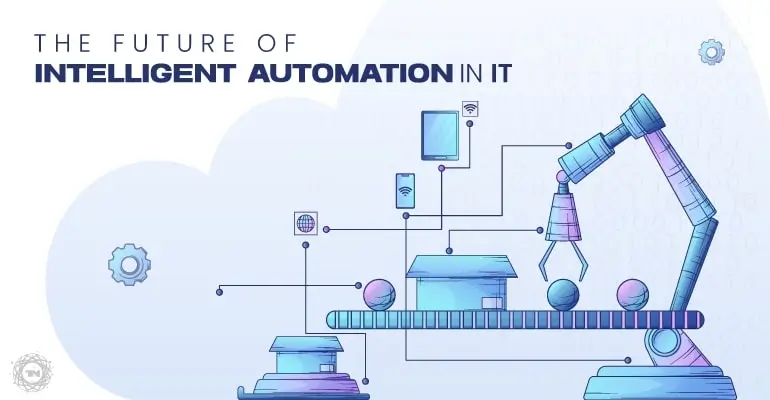The future of intelligent automation in IT holds immense potential for revolutionising how businesses operate. Intelligent automation, which integrates artificial intelligence (AI) and machine learning (ML) with traditional automation, enhances operational efficiency and drives innovation and strategic decision-making. This blog delves into the various facets of intelligent automation in IT, exploring its current trends, future possibilities, and the transformative impact it is set to have on industries worldwide.

The Future of Intelligent Automation in IT.
Understanding Intelligent Automation in IT
Intelligent automation in IT refers to using AI and ML technologies to automate complex processes, making them more efficient and adaptive. Unlike traditional automation, which relies on predefined rules and scripts, intelligent automation can learn from data, adapt to new situations, and improve over time. This advanced form of automation can handle unstructured data, make decisions based on real-time analysis, and interact with humans more naturally and intuitively.
Key Components of Intelligent Automation
- Artificial Intelligence: AI enables machines to perform tasks that typically require human intelligence, such as visual perception, speech recognition, decision-making, and language translation. In the context of intelligent automation, AI algorithms analyse vast amounts of data to identify patterns and insights that drive automated processes.
- Machine Learning(ML): This subset of AI involves training algorithms to learn from data and improve performance over time without being explicitly programmed. ML is crucial for developing predictive models and enhancing the adaptability of automated systems.
- Robotic Process Automation: RPA automates rule-based and repetitive operations with software robots. When combined with AI and ML, RPA becomes more intelligent and capable of handling more complex processes that require decision-making and problem-solving.
- Natural Language Processing: NLP enables machines to understand and interpret human language, facilitating more effective communication between humans and automated systems. This is particularly useful in customer service and support roles, where chatbots and virtual assistants are becoming increasingly prevalent.
Current Trends in Intelligent Automation
The adoption of intelligent automation in IT is accelerating, driven by several key trends:
- Enhanced Customer Experience: Businesses leverage intelligent automation to enhance customer experience by providing faster, more accurate, personalised services. Chatbots and virtual assistants powered by AI and NLP can handle various customer inquiries, reduce response times, and improve satisfaction.
- Improved Operational Efficiency: Intelligent automation streames IT operations by automating routine tasks like monitoring, maintenance, and security management. This reduces the workload on IT staff and minimises the risk of human error, leading to more reliable and efficient operations.
- Data-Driven Decision Making: Intelligent automation, which can analyse vast amounts of real-time data, empowers businesses to make more informed, data-driven decisions. Predictive analytics and ML models help organisations identify trends, anticipate future needs, and optimise their strategies.
- Scalability and Flexibility: Intelligent automation solutions are highly scalable and flexible, allowing businesses to adapt to changing demands and scale their operations seamlessly. This is particularly valuable in dynamic industries where agility and responsiveness are critical to success.
The Future Possibilities of Intelligent Automation in IT
The future of intelligent automation in IT is poised to bring even more transformative changes.
- Autonomous IT Operations: One of the most exciting prospects of intelligent automation is the development of fully autonomous IT operations. Soon, IT systems can monitor, diagnose, and resolve issues without human intervention. This will significantly reduce downtime, enhance system reliability, and free up IT professionals to focus on more strategic initiatives.
- Enhanced Cybersecurity: As cyber threats become more sophisticated, intelligent automation will enhance cybersecurity measures. AI and ML algorithms can detect anomalies, identify potential threats, and respond to real-time security incidents. This proactive approach to cybersecurity will help organisations stay ahead of emerging threats and protect their valuable data assets.
- Hyper-Automation: Hyper-automation refers to combining multiple automation technologies to achieve end-to-end automation of business processes. Businesses can automate complex workflows across various departments and functions by integrating AI, ML, RPA, and other advanced technologies. This holistic approach to automation will significantly improve efficiency, accuracy, and overall business performance.
- Human-Machine Collaboration: The future of intelligent automation will emphasise human-machine collaboration. Rather than replacing humans, intelligent automation will augment human capabilities, enabling employees to focus on higher-value tasks that require creativity, critical thinking, and emotional intelligence. This collaborative approach will lead to more innovative solutions and a more engaged and productive workforce.
- Challenges and Considerations: While the future of intelligent automation in IT is promising, it has. Organisations must address several key considerations to implement and harness the full potential of intelligent automation successfully:
- Change Management: Implementing intelligent automation requires a cultural shift within organisations. Change management strategies must be in place to address employee concerns, provide adequate training, and ensure a smooth transition to automated processes.
- Data Privacy and Security: Increased reliance on data-driven automation makes data privacy and security paramount. Organisations must implement strong security measures and adhere to relevant regulations to safeguard sensitive information.
- Ethical Considerations: Using AI and ML raises ethical considerations, such as algorithm bias and job impact. Organisations must adopt ethical guidelines and practices to ensure fairness, transparency, and accountability in their automation initiatives.
Conclusion
The future of intelligent automation in IT will transform how businesses operate, driving efficiency, innovation, and strategic growth. As AI, ML, and other advanced technologies evolve, intelligent automation will become integral to IT operations, enabling organisations to stay competitive in an increasingly digital world. By embracing intelligent automation and addressing the associated challenges, businesses can unlock new opportunities and pave the way for a more efficient, secure, and innovative future.
Tags: ChatGPT, Cloud Computing, Digital Marketing Funnel
